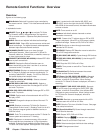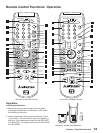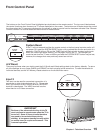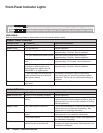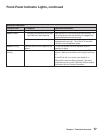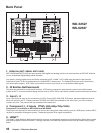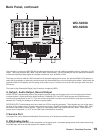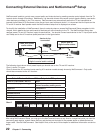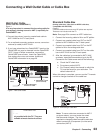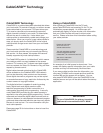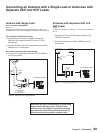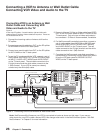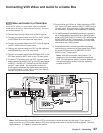20
Chapter 1. Television Overview
9. DTV Link/IEEE 1394
These jacks allow the TV to connect to external IEEE 1394 digital products by means of a single cable. Two jacks are
provided for this purpose, allowing for a high degree of flexibility in connecting your NetCommand®-controlled system.
Detailed information regarding IEEE 1394 connection requirements are in Chapter 4.
10. CableCARD™ Slot
The CableCARD access card provided by your cable TV service provider is inserted into this slot. The top of the card should
face up as indicated by the direction of the CARD TOP arrow. When you use the CableCARD Slot, you must connect the
cable to ANT-1.
CableCARD is a nationwide standard system that allows your local cable TV provider to supply you with an access card
customized to your account. This card allows the TV to receive, decode and unscramble the premium digital channels
included in your cable TV subscription without the use of a cable box. See page 22 for additional CableCARD information
and activation instructions.
If your cable company is not currently offering CableCARD access cards, you will need to use a cable box provided and
authorized by your local cable company to view scrambled channels.
11. Digital Audio Output
This output sends Dolby® Digital or PCM digital audio to your digital A/V surround sound receiver. Analog audio from analog
channels and devices is converted by the TV to PCM digital audio. In most cases, this should be the only audio connection
between the TV and your A/V receiver. If you have MP3 audio sources, however, you need to connect the TV’s analog
AUDIO OUTPUT (left and right) to your A/V receiver.
Back Panel, continued
A Note About Temporary Residual Images
Prolonged display of stationary images on your TV may cause faint, residual “ghost” images to be visible when viewing
other programs. THIS EFFECT IS TEMPORARY. The residual images will disappear within days or weeks. Most TV
and DVD programming is of generally uniform brightness and will not produce this effect.
To prevent the appearance of residual images:
• Avoid display of stationary images for extended periods on this or any other LCD projection TV. Examples of such
images include:
∙ Stationary images that may be part of video games and web pages
∙ Bright, stationary icons overlaid on moving video
∙ Side bars displayed with narrow-format video (see definition on page 80)
∙ Top and bottom bars displayed with letter-box video (see definition on page 80)
• Mix regular TV and video programming with uses that display stationary images.



